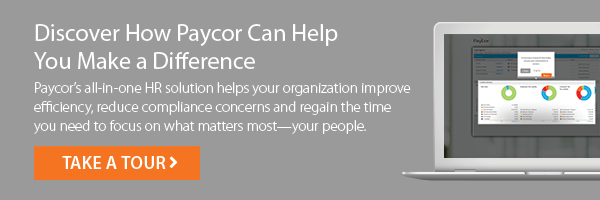Pay equity is an important part of HR compliance. Historically, pay inequality has had a greater impact on workers with specific marginalized groups. However, it can impact anyone – and you might not realize it until it’s happening.
Use this resource to understand pay equity, guard against discrimination, and keep your company compliant.
What Is Pay Equity?
Simply put, pay equity means equal pay for equal work. Regardless of their gender, race, or other demographics, employees with the same duties should receive comparable compensation.
But pay equity isn’t just about ethics; it’s also a compliance issue. Since the 1960s, every U.S. state has strengthened its pay equity laws – some more than others. And these laws continue to change.
To keep their companies compliant, HR leaders need to track those changes.
Why is Pay Equity Important?
Offering equitable pay has a sizeable impact on employee morale, empowering HR to reach key goals.
Compliance
Several local and federal laws require employers to provide equal pay for equal work. Failing to comply with these laws poses a serious risk to your company. If you want to protect your team from fees and legal problems, pay equity should be a high priority.
Employee Motivation
Transparent pay equity practices can motivate team members to learn new skills, take on high-profile assignments, and compete for pay increases. On the other hand, if an employee believes they’ll be passed over for a promotion or a raise, they could easily grow disengaged at work.
Employee Retention
Pay equity also affects long-term employee retention. In one survey, 83% of employees said compensation played a role in their decision to quit a job (LinkedIn). While this isn’t the only factor driving turnover, it could be a tipping point for some valuable members of your team – especially women, BIPOC employees, and other members of historically marginalized groups at risk for pay inequity.
Company Culture
Promoting equity of any kind – including pay equity – improves company culture. These practices demonstrate how much you value your people, which encourages workers to do the same. By following pay equity best practices, HR sets the tone for a company culture of recognition, appreciation, and gratitude.
Employer Reputation
Pay equity best practices can dramatically improve your company’s reputation among job candidates, investors, and customers. For example, what would potential partners see if they looked up your company on Glassdoor? What do current and former employees say about your compensation? Think of your compensation strategy as being part of your marketing strategy. Over time, pay equity can have a major impact on company profits and growth.
The Difference Between Pay Equity and Pay Equality
The terms pay equity and pay equality are often used interchangeably, but they have two distinct meanings.
Pay equity means paying people fairly based on their qualifications and workload, regardless of their race, ethnicity, gender, and other demographic attributes.
Pay equality means paying people fairly based on the value of their work, regardless of their qualifications or workload.
Unfortunately, focusing only on pay equality (instead of pay equity) often results in pay gaps between people of different demographics. Research shows there is “no single explanation” for these gaps (Pew Research Center), but social norms, parenthood, and age can all play a role. Both pay equity and pay equality seek to level the playing field; however, pay equity does a better job of accounting for historical disparities.
Pay Equity Laws: A Brief History
Both federal and state laws govern pay equity. Federally, the Equal Pay Act of 1963 requires employers to pay men and women equally. Title VII, of the 1964 Civil Rights Act, also prevents “discrimination against employees based on race, color, religion, sex, or national origin” (U.S. Equal Employment Opportunity Commission).
These laws are an important baseline, but they didn’t erase inequality. For one thing, the Equal Pay Act only applies to workers in the same workplace (University of Minnesota). If a company has biased hiring practices, it doesn’t matter that they would pay people the same amount for equal work. This problem is so widespread, some HR teams now use AI-based recruiting software to cut down on implicit bias.
Regulations vary widely on the state level. In California, for example, employers can’t discriminate based on actual or perceived race, religion, ancestry, disability, marital status, gender identity, gender expression, military or veteran status, and several other criteria.
In Missouri, the list of restrictions is much shorter, only including “race, color, religion, national origin, sex, ancestry, age (40 to 69), or disability” (The Pay Equity Project).
Causes of Pay Equity Gaps Today
Pay equity gaps can be a serious problem, and they can arise unintentionally. If your company doesn’t conduct regular pay equity analyses, you could be following outdated workflows and best practices. In some cases, that can lead to a biased compensation strategy. There are several reasons pay equity gaps became so common:
- Historically, people from marginalized groups (like women, BIPOC, and LGBTQIA+ people) have had less access to education and financial resources. That makes it easier for employers to justify offering them lower wages.
- For younger workers of these identities, it’s hard to find mentors who share their experience and can offer relevant career advice.
- People who experience oppression – especially BIPOC people – have a harder time getting hired (Northwestern University). By the time they do accept a job, they might be more willing to take a low-ball offer.
- Despite some states’ pay transparency laws, people just don’t talk about money. A lot of people don’t know what a fair wage would be, even for their own work. As a result, they don’t negotiate with new employers or ask for what they’re worth.
Few employers, if any, set out to offer unfair wages. But because of these factors, it can be hard to recognize inequities. That’s why HR leaders need the right systems in place to interrupt implicit bias.
Conducting a Pay Equity Analysis
If you’re just starting to implement pay equity best practices, HR should begin with a formal pay equity analysis. This process is a deep dive into your compensation data, broken down by various demographic factors like gender and race. If you find unintentional disparities, you can use that data to update your compensation strategy. Pay equity analysis typically entails:
- Data Collection: Gather comprehensive compensation data, including salary, bonuses, and other forms of payment.
- Statistical Analysis: Identify and quantify pay gaps between different groups based on employee demographics like gender, race, and ethnicity.
- Control for Variables: As you analyze pay data, control for legitimate factors that can influence compensation such as education, experience, job tenure, and performance ratings.
- Identify Root Causes: Aim to uncover any systemic factors that may contribute to pay disparities. These could include biased hiring or promotion practices or differences in performance evaluations.
- Monitor Changes: Pay equity analysis should be an ongoing process. Perform regular audits to track progress, identify emerging disparities, and maintain pay equity over time.
Pay Equity Best Practices
There are several ways HR can achieve pay equity. All of these best practices improve company culture, engagement, and retention. Some are also legal requirements that keep your company compliant. To achieve pay equity, HR leaders should:
- Identify Pay Transparency Laws: Some state laws require companies to report how much they pay employees. Because these laws change over time, HR should conduct regular research to keep up with new regulations.
- Establish Pay Equity Guidelines: Using state and federal laws as a starting point, compile the pay equity guidelines your company will follow. Work with the C-suite to ensure these guidelines align with the business’s mission and budget.
- Provide Pay Scale Details: Whether or not your state has pay transparency laws, open communication builds trust with employees. HR should encourage company leadership to share details about the business’s compensation strategy whenever possible.
- Conduct Pay Audits: Conduct regular, company-wide salary reviews to analyze compensation data and identify disparities. Partnering with third-party experts can make these reviews even more objective.
- Implement Implicit Bias Training: Implicit biases are opinions we don’t even know we have. With training, you and your team can learn to notice and interrupt your own assumptions.
- Report Information Properly: By federal law, certain employers have to file EEO-1 reports with employee demographics. These reports help the government identify discrimination. EEO-1 deadlines are different every year, and compliance requirements can change rapidly. HR leaders need to stay informed about the reporting process. In the meantime, make sure you track and record employee information well in advance, so your team is prepared for whatever comes your way.
These steps are a great place to start, but there’s always more to learn. Consider how pay equity works in your specific area and industry. You can also talk to a legal expert to set priorities for your company.
Additional Factors That Impact Pay Equity
The Equal Pay Act focuses on gender, but several other factors can contribute to pay inequity. These factors can also intersect and compound, making it even harder for certain employees to receive equitable pay.
Age
In some situations, it’s fair to pay older workers based on their experience, qualifications, and workload. No one expects the newly graduated intern to earn as much as the CFO. However, age should never be the reason for a difference in pay. Age discrimination is a growing problem, especially for workers over 50. One survey found that among adults in the workforce, 14% were not hired for a job because of their age (AARP).
Experience
Experience can be a legitimate factor in determining pay, as employees with more years in a role or industry typically bring greater expertise and value. However, make sure you evaluate experience in the context of other factors – like your hiring practices. For example, if women or BIPOC employees are consistently hired into lower-level roles, they’ll have fewer opportunities to gain the experience that leads to higher pay.
Education
Like age and experience, education can qualify them for higher-paying jobs. Pay inequity can still exist within education levels, with women and BIPOC employees sometimes earning less than their white male counterparts with the same qualifications. To combat this, HR should regularly analyze pay data and ensure that education is valued consistently across all employee demographics.
Position
Pay equity best practices encourage HR to look at the value of a person’s work, not just their job title. Inequities can arise when positions mainly held by women are paid less than positions mainly held by men. HR should regularly review the company’s role valuation processes to prevent unintentional bias or discrimination.
Certifications
Obtaining new certifications can – and should – increase an employee’s earning potential. But that only works when employees have equal access to certification opportunities. Employers should support workers of all backgrounds in their efforts to grow their careers.
Pay Equity Frequently Asked Questions
Why should you conduct a pay equity analysis?
Conducting a pay equity analysis helps companies identify and correct unfair pay disparities. It promotes fairness and ensures that employees are compensated equitably, regardless of gender, race, or other protected characteristics. Pay equity analyses also help HR comply with legal requirements, enhance their reputation, and attract and retain top talent.
How often should a company conduct a pay equity analysis?
Most companies should conduct pay equity analyses at least every one to two years. However, the frequency may vary based on your company’s size and complexity. HR should also conduct a pay equity analysis whenever there are significant changes in compensation structures, such as after a merger or acquisition, or when implementing a new HRIS.
When should you analyze your employees’ pay equity?
HR should proactively analyze pay equity for individual employees and job titles. Don’t wait until a complaint arises. Instead, employee pay equity analysis should be an ongoing process integrated into regular HR and compensation practices. Conduct your analysis during annual compensation reviews, when setting salary ranges for new positions, and when making promotion decisions.
What is the ROI on Pay Equity?
While pay equity has a significant return on investment (ROI), it’s difficult to quantify in strict financial terms. Pay equity has a notable impact on employee morale, engagement, and retention, along with compliance and employer reputation. As a result, fair pay practices contribute to long-term, sustainable financial success.
What is the Pay Equity Act?
There is no single, universal “Pay Equity Act” in the United States. Instead, pay equity is addressed through a combination of federal and state laws. The Equal Pay Act of 1963 is a federal law that prohibits pay discrimination based on gender for employees performing the same job under similar working conditions. Title VII of the Civil Rights Act of 1964 prohibits discrimination in compensation based on race, color, religion, sex, and national origin. Many states have enacted additional pay equity laws that provide various protections.
How Paycor Helps You Achieve Pay Equity
Paycor’s tools empower HR to work toward pay equity, promoting employee engagement and retention. Here’s how:
Recruiting Software
Pay equity impacts every part of the employee life cycle, from hire to retire. Our AI-powered recruiting software cuts down on implicit bias in the hiring process, helping leaders expand the talent pool and avoid costly compliance problems down the line.
Talent Management
Our Talent Management software empowers leaders to understand each employee’s strengths, learning opportunities, and value to the company. You can also track employees’ growth over time and identify which specific roles you should focus on during pay equity audits.
Paycor Analytics
After you conduct a pay equity analysis, how do you analyze your findings? Unevaluated data is just white noise. Paycor Analytics gives HR valuable insights about the metrics and trends that matter most, empowering you to work toward pay equity for the entire company.
Use Paycor to Achieve Employee Pay Equity
Creating a fair, positive corporate culture is a lot of work. So is staying compliant. Both these monumental tasks fall to HR – and if you want to achieve them, you need the right tools for the job. That’s why Paycor offers a robust suite of HR software, purpose-built for leaders.
Connect with us to learn how Paycor can help you institute fair hiring practices, improve company culture, and drive results.










